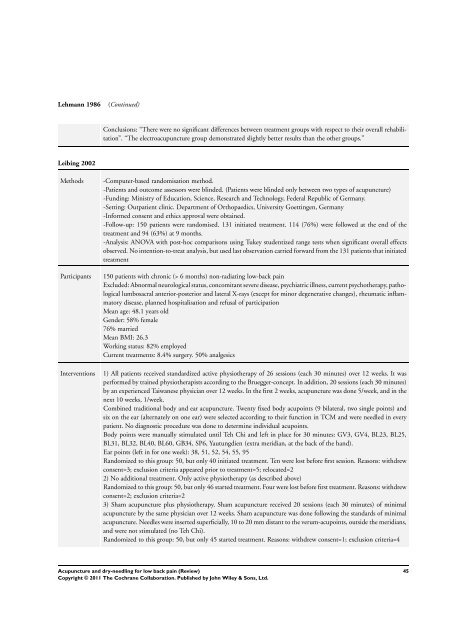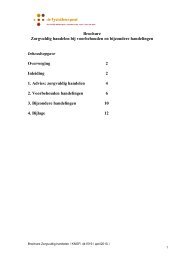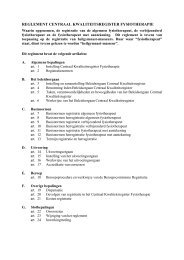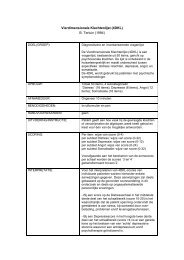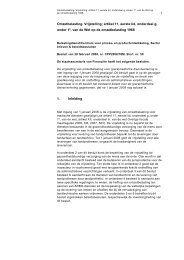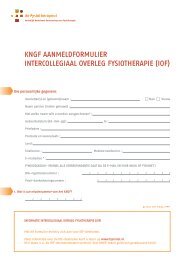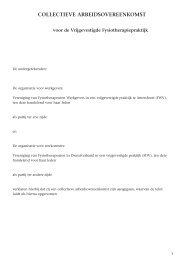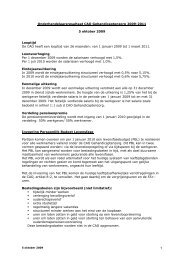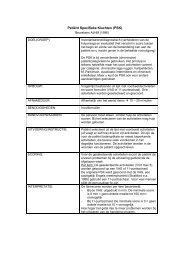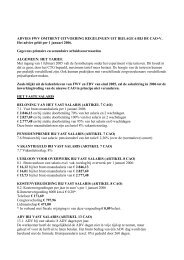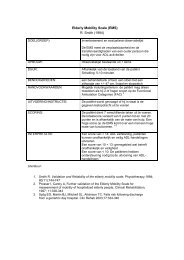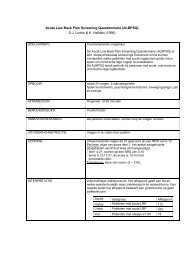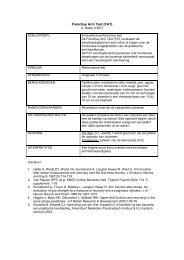Acupuncture and dry-needling for low back pain (Review)
Acupuncture and dry-needling for low back pain (Review)
Acupuncture and dry-needling for low back pain (Review)
You also want an ePaper? Increase the reach of your titles
YUMPU automatically turns print PDFs into web optimized ePapers that Google loves.
Lehmann 1986<br />
(Continued)<br />
Conclusions: “There were no significant differences between treatment groups with respect to their overall rehabilitation”.<br />
“The electroacupuncture group demonstrated slightly better results than the other groups.”<br />
Leibing 2002<br />
Methods<br />
Participants<br />
Interventions<br />
-Computer-based r<strong>and</strong>omisation method.<br />
-Patients <strong>and</strong> outcome assessors were blinded. (Patients were blinded only between two types of acupuncture)<br />
-Funding: Ministry of Education, Science, Research <strong>and</strong> Technology, Federal Republic of Germany.<br />
-Setting: Outpatient clinic. Department of Orthopaedics, University Goettingen, Germany<br />
-In<strong>for</strong>med consent <strong>and</strong> ethics approval were obtained.<br />
-Fol<strong>low</strong>-up: 150 patients were r<strong>and</strong>omised. 131 initiated treatment. 114 (76%) were fol<strong>low</strong>ed at the end of the<br />
treatment <strong>and</strong> 94 (63%) at 9 months.<br />
-Analysis: ANOVA with post-hoc comparisons using Tukey studentized range tests when significant overall effects<br />
observed. No intention-to-treat analysis, but used last observation carried <strong>for</strong>ward from the 131 patients that initiated<br />
treatment<br />
150 patients with chronic (> 6 months) non-radiating <strong>low</strong>-<strong>back</strong> <strong>pain</strong><br />
Excluded: Abnormal neurological status, concomitant severe disease, psychiatric illness, current psychotherapy, pathological<br />
lumbosacral anterior-posterior <strong>and</strong> lateral X-rays (except <strong>for</strong> minor degenerative changes), rheumatic inflammatory<br />
disease, planned hospitalisation <strong>and</strong> refusal of participation<br />
Mean age: 48.1 years old<br />
Gender: 58% female<br />
76% married<br />
Mean BMI: 26.3<br />
Working status: 82% employed<br />
Current treatments: 8.4% surgery. 50% analgesics<br />
1) All patients received st<strong>and</strong>ardized active physiotherapy of 26 sessions (each 30 minutes) over 12 weeks. It was<br />
per<strong>for</strong>med by trained physiotherapists according to the Bruegger-concept. In addition, 20 sessions (each 30 minutes)<br />
by an experienced Taiwanese physician over 12 weeks. In the first 2 weeks, acupuncture was done 5/week, <strong>and</strong> in the<br />
next 10 weeks, 1/week.<br />
Combined traditional body <strong>and</strong> ear acupuncture. Twenty fixed body acupoints (9 bilateral, two single points) <strong>and</strong><br />
six on the ear (alternately on one ear) were selected according to their function in TCM <strong>and</strong> were needled in every<br />
patient. No diagnostic procedure was done to determine individual acupoints.<br />
Body points were manually stimulated until Teh Chi <strong>and</strong> left in place <strong>for</strong> 30 minutes: GV3, GV4, BL23, BL25,<br />
BL31, BL32, BL40, BL60, GB34, SP6, Yautungdien (extra meridian, at the <strong>back</strong> of the h<strong>and</strong>).<br />
Ear points (left in <strong>for</strong> one week): 38, 51, 52, 54, 55, 95<br />
R<strong>and</strong>omized to this group: 50, but only 40 initiated treatment. Ten were lost be<strong>for</strong>e first session. Reasons: withdrew<br />
consent=3; exclusion criteria appeared prior to treatment=5; relocated=2<br />
2) No additional treatment. Only active physiotherapy (as described above)<br />
R<strong>and</strong>omized to this group: 50, but only 46 started treatment. Four were lost be<strong>for</strong>e first treatment. Reasons: withdrew<br />
consent=2; exclusion criteria=2<br />
3) Sham acupuncture plus physiotherapy. Sham acupuncture received 20 sessions (each 30 minutes) of minimal<br />
acupuncture by the same physician over 12 weeks. Sham acupuncture was done fol<strong>low</strong>ing the st<strong>and</strong>ards of minimal<br />
acupuncture. Needles were inserted superficially, 10 to 20 mm distant to the verum-acupoints, outside the meridians,<br />
<strong>and</strong> were not stimulated (no Teh Chi).<br />
R<strong>and</strong>omized to this group: 50, but only 45 started treatment. Reasons: withdrew consent=1; exclusion criteria=4<br />
<strong>Acupuncture</strong> <strong>and</strong> <strong>dry</strong>-<strong>needling</strong> <strong>for</strong> <strong>low</strong> <strong>back</strong> <strong>pain</strong> (<strong>Review</strong>)<br />
Copyright © 2011 The Cochrane Collaboration. Published by John Wiley & Sons, Ltd.<br />
45


